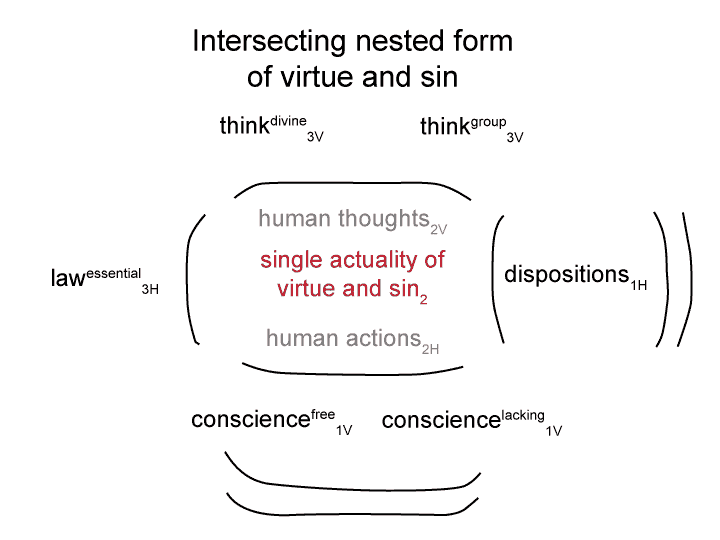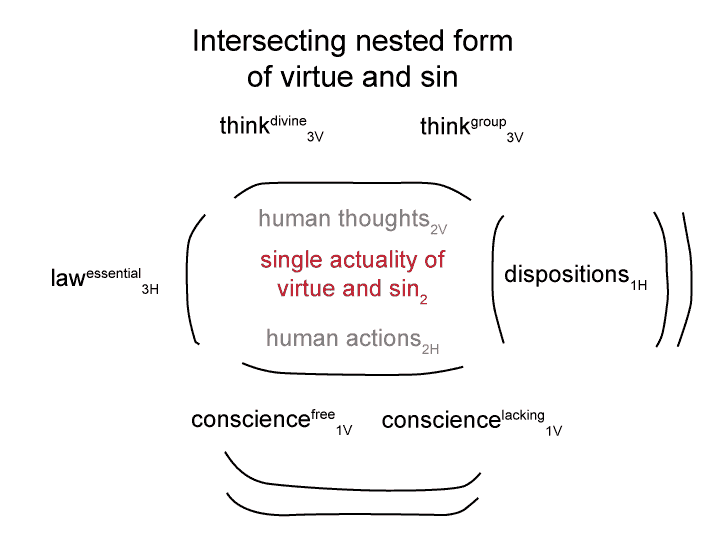Man and Sin by Piet Schoonenberg (1964) 2.2 DY
Summary of text [comment] page 78
The limited goods (that a sinful person chooses) have a tendency to slip away. A sinful person may cling to a shred of virtue. But only for so long.
Schoonenberg wrote that fallen man is unable, without grace, to keep the commandments of the natural law for a long time.
[Why did Schoonenberg refer to ‘the commandments of the natural law’ and not ‘the divine law’?
Does Schoonenberg conflate thinkdivine and lawessential?
Or does his intuition implicitly comply with the explicit model of the intersection of virtue and sin?]
Man and Sin by Piet Schoonenberg (1964) 2.2 DX-2
[The hero stands for Progressive television producers (whose way of talk exploits the viewers, since they cannot talk back). The victim stands for the viewer (who cannot talk back to the television, therefore is a victim).
The expectation is that the victim-viewer will join the television producer-exploiter in a mutual hatred of the one designated as the anti-object. ‘The bad one’, in many these shows, stands in for those who do not watch TV and mind their own business.
Thus, in contradiction to Jesus’ words in John 15:5, the so-called Progressive mainstream American TV portrays a world where both producer and viewer love one another while both hating their fellow “man” (the stock character accused of the projector’s moral failures).]
Man and Sin by Piet Schoonenberg (1964) 2.2 DX-1
[Watch American television in 7816 U0′ in that regard.
The stock American TV show goes like this:
A hero and a victim appear to join together in order to identify and destroy the victimizing bad person.
Televisionary moral good foils a third party; a stock character who is responsible for making the victim who “he” is.]
Man and Sin by Piet Schoonenberg (1964) 2.2 DW-2
[For example, let us say that an administrator conveys a false sense of ‘victimhood’ onto someone in order to ‘save the victim’ through sovereign power.
The rescued victim may find that the administrator is using “him” to validate the administrator’s exercise of disciplinary power.
The administrator’s limited good is self-serving.
The opportunity to exhibit how I am more righteous than others offers just as much a temptation for some as alcohol offers for others.]
Man and Sin by Piet Schoonenberg (1964) 2.2 DW-1
Summary of text [comment] page 78
[The limited goods, that the sinful “man” may choose and realize, tend towards specific moral attitudes. Examples include self, family, tribe, nation, and political party.
For example, let us say that a person chooses the limited group of tribe.
Preferential acts of kindness to those in the tribe will be a limited good.]
Man and Sin by Piet Schoonenberg (1964) 2.2 DV
[The person may occasionally act as if “he” were choosing the moral good.
The dispositions, influenced by moral actions, may adjust.
However, the interpellation of thinkgroup is also in play.
Thinkgroup may be so pervasive that the person, in choosing what appears to be a moral good, only adopts another form of slavery.]
Man and Sin by Piet Schoonenberg (1964) 2.2 DU
Summary of text [comment] page 77
Under sinful circumstances, a sinner may choose a good on “his” own, but not the moral good that is the object of virtue. “He” can choose only limited goods, provided, of course, that “his” dispositions have not already been trained by sinful habitual actions.
[Here, the model of intersecting nested forms assists.
Even when consciencelacking has made the person unfree (that is, dependent on the thinkgroup), the parallel vertical nested form of thinkdivine still interpellates.]
Man and Sin by Piet Schoonenberg (1964) 2.2 DS
[Schoonenberg’s comments can be portrayed through a familiar intersection, the message underlying the word ‘religion’.
Sin and virtue are actualities that both situate and emerge from our dispositions and conscience (free will). The physical ability to love goes with the dispositions. The moral ability (or inability) to love goes with conscience.
I label ‘the moral ability to love’ ‘consciencefree’.
Here, ‘free’ means freedom from a thinkgroup that makes you a slave to a sinful behavior.
The ‘moral inability to love’, corresponds to ‘consciencelacking’, which means a conscience lacking in freedom.]


